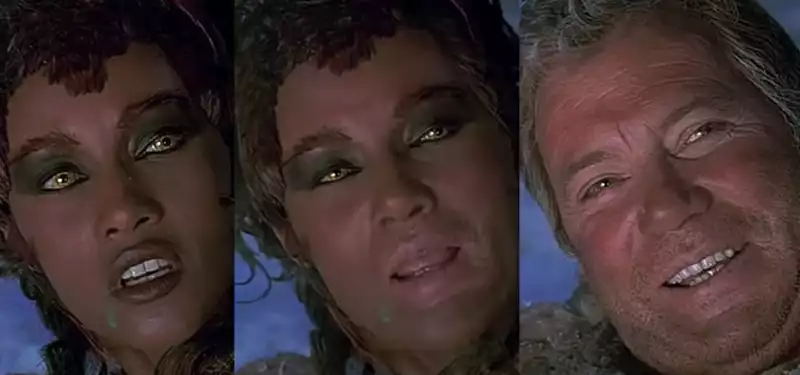Dec 11, 2016
10 Unforgettable Morph in Movies, TV and Music Videos
With Michael Jackson's Black or White music video and its seminal morphing sequence by PDI celebrating its 25th anniversary (read our oral history of the project), we've decided to take a look back at some of the best examples of digital morphing over the years.
Some of these pre-date Black or White. Others came during a time when morphing crowded visual effects on screen. Later uses exemplify how morphing developed into a seamless 'fix-it' compositing solution until 3D morphing with blend-shapes became the norm.
Audiences got their first taste of modern digital morphing – the seemingly magical blending of two elements – in Ron Howard's Willow. This was thanks to ILM software called 'Morf' developed by CG supervisor Doug Smythe. It was used to transition actress Patricia Hayes from a goat into an ostrich, a peacock, a tortoise, and a tiger (some of these were real animals and some articulated puppets). Smythe and Tom Brigham ultimately won an Academy Scientific and Technical Achievement Award in recognition of their work on Morf.
Morf was also relied upon for the grotesque aging and death of Nazi sympathizer Walter Donovan (Julian Glover) after he drinks from the wrong cup in this Steven Spielberg film. Several multiple-stage make-ups were shot separately and then morphed by ILM. The sequence is particularly remarkable for its use of all-digital compositing, in that the original film elements were scanned into the computer with a new laser scanner and then the final frames also outputted this way (rather than via an optical printer).
Robert Patrick's liquid metal character, the T-1000, in James Cameron's film was almost born for morphing. The shape-shifting terminator was a computer generated effect that could take almost any form. That meant for many shots, ILM would utilize model interpolation to change between shapes. However, there were many other examples in the film where Patrick transformed into human characters or metal shapes using traditional morphing methods, and it was here that Morf came into use once again.
ILM's dominance of the morphing world continued in this sixth Star Trek film (which came out right after the world had seen the morphing sequence in Black or White). Here, the studio conducted their morph on the characters – in this case Iman as the alien Martia and William Shatner as Captain James T. Kirk – while they were still mid-sentence, something they hadn't done previously.
This music video for David Byrne's single featured an array of morphing effects by PDI, fresh off of its success with Black or White and part of a run of years of morphing effects – and related income – from the studio. It was also an opportunity for PDI to show off warping effects (ie. not necessarily transitions or blends between objects, but instead ways to stretch and twist the human body in semi-convincing ways). Still, there were plenty of guitar morphs to enjoy.
It wasn't long before episodic television embraced morphing, with one of the more impressive efforts seen for the Changeling characters in Deep Space Nine. In particular, Odo (René Auberjonois) had numerous shape-shifting abilities, including into a hawk and a dog. VisionArt and Digital Muse carried out morphing duties during the series.
Bjork's high-art music promos have constantly bedazzled viewers, and none more so than this piece which saw the singer stage an internal battle within before being revealed as a futuristic polar bear. Digital Domain worked on the morphing which was notable for its addition of 3D CGI bear pelts that intermingled with the skin of the live-action Bjork.
Two films from 1997 exemplified how far morphing had come by then. Whereas previously it had been used to mostly blend between characters or creatures, filmmakers soon began to take advantage of the effect's ability to hide transitions by using it to blend between locations and create dramatic single shots. In Contact, a tracking shot that follows Jodie Foster out of her car, an exterior, into a satellite tracking array center, an interior, used morphing – or 'blorphing' (blend/morphing) as visual effects supervisor Ken Ralston described it, to hide the fact that the two places were not at the same location. The work was done by ILM.
Meanwhile, Digital Domain crafted its own blorph for the final long shot in Titanic where the camera dives down into the sunken ship and then transitions from the murky deck into a pristine 1912 ship. The studio combined miniatures, motion control footage, live-action plates, and cg elements to make the shot possible.
By the late 1990s, morphing had mostly fallen out of favor as a go-to and frontline effect in film and television (although it still made several appearances in commercials). With the TV show Grimm, however, morphing seemed to make a dramatic comeback. While retaining the 'look' of a morph, the truth behind the shots was a mix of blend-shapes of cg creatures and cg humans, and compositing, thanks to the significant efforts of studios including Hive FX and Bent Image Lab.
The Wolverine's dramatic ending in which the titular mutant takes on the Silver Samurai pushed the tech further. Inside the Samurai suit was a man, Yashida, thought dead but who seeks to steal Wolverine's healing powers. In the process we see him transition from old to young, but then back again when Wolverine gets the upper hand. Weta Digital steered clear of a typical morph look in crafting cg versions of the character at different stages with some detailed animation and compositing. It's still morphing, but perhaps not as we used to know it.
Be sure to share your favorite morphs in the comments below.




Post your comment